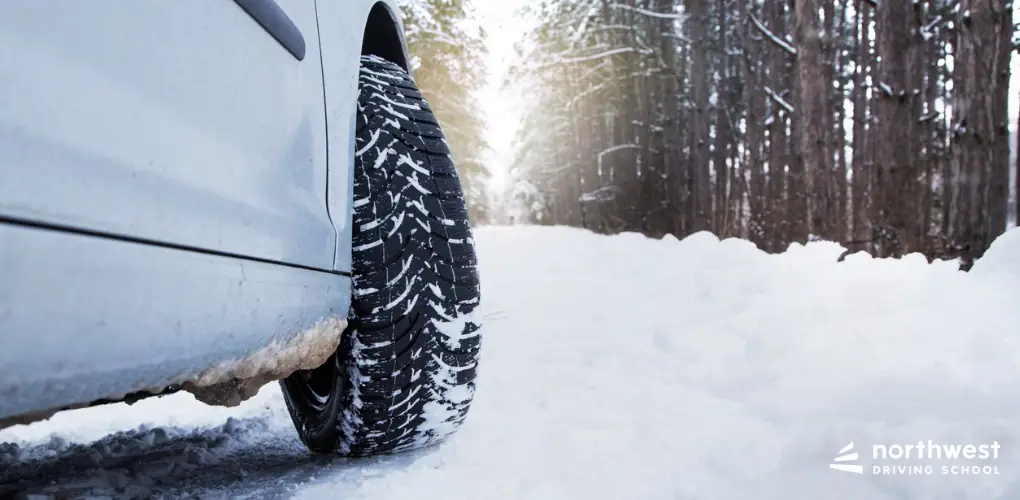- Driving School
Safety Tips For Winter Driving

Even for experienced drivers, driving in harsh winter weather can be challenging and dangerous. The combination of snow, ice, and freezing temperatures can create hazardous road conditions that increase the risk of accidents.
To help you make safer decisions while driving in winter, the expert driving instructors at Northwest Driving School have put together this guide with tips and advice on how to minimize the risk of accidents in difficult weather conditions.
Read More: How To Drive In Winter Weather
Table of Contents
Preparing your vehicle
Before heading out on the road in winter, it’s important to make sure your vehicle is prepared for the weather conditions. Here are some essential things you should do:
- Check your tires: Make sure your tires have enough tread and are properly inflated. In snowy or icy conditions, it’s recommended to use winter tires as they provide better traction and handling.
- Test your battery: Cold temperatures can drain a car battery, so it’s important to ensure yours is in good condition before winter arrives. If your battery is old or weak, consider replacing it.
- Keep your gas tank at least half full: This not only prevents you from running out of gas in the cold but also adds weight to the vehicle, providing better traction on slippery roads.
- Check all fluids: Make sure your vehicle’s fluids, such as oil, antifreeze, and windshield wiper fluid, are at the appropriate levels. It’s also recommended to use winter-grade fluids for better performance in cold weather.
- Pack an emergency kit: In case of any unexpected emergencies or breakdowns, it’s always a good idea to have an emergency kit in your car. This should include items such as a flashlight, first aid kit, warm blankets, and non-perishable food.
How to Drive in Winter Weather
Once you’ve prepared your vehicle, it’s important to adjust your driving habits according to the weather conditions. Here are some helpful tips:
- Slow down: It takes longer to stop on icy or snowy roads, so reduce your speed and leave plenty of space between you and the vehicle in front of you.
- Avoid sudden movements: Be gentle with your steering, braking, and acceleration to avoid losing control on slippery roads.
- Use your headlights: Visibility can be reduced during winter weather, so make sure to use your headlights even during daylight hours.
- Brake properly: If your car has anti-lock brakes (ABS), apply firm and continuous pressure to the brake pedal. If you don’t have ABS, pump your brakes lightly to avoid skidding.
- Steer into a skid: If you do start to skid, take your foot off the gas and steer in the direction of the skid until you regain control of your vehicle.
- Use your signals: Be sure to use your turn signals earlier than usual and give other drivers more notice of your intentions.
- Stay alert: Winter weather conditions can be unpredictable, so it’s important to stay focused and alert while driving. Avoid distractions such as using your phone or eating while behind the wheel.
Read More: How To Drive In Stormy Weather Conditions
What to Do in Case of an Accident
Even with all the necessary precautions, accidents can still happen. If you find yourself in an accident during winter weather conditions, here’s what you should do:
- Stay calm: It’s natural to feel shocked and overwhelmed after an accident but try to stay as calm as possible.
- Check for injuries: First and foremost, check yourself and any passengers for injuries. If anyone is injured, call for medical assistance immediately.
- Move to a safe place: If possible, move your vehicle out of the way of traffic and find a safe place to wait for help.
- Call the police: Regardless of how minor the accident may seem, it’s important to report it to the police. They can provide you with an official report which can be helpful when filing an insurance claim.
- Take photos: If it’s safe to do so, take photos of the accident scene and any damages to your vehicle. These can also be helpful when filing an insurance claim.
- Exchange information: Exchange contact and insurance information with the other driver(s) involved in the accident.
When Not to Drive
Sometimes, the safest option is to not drive at all in severe winter weather. Here are some situations where it’s best to stay off the roads:
- Whiteout conditions: If visibility is extremely poor, it’s better to wait for the storm to pass before driving.
- Ice storm or freezing rain: These conditions can make roads treacherous, and even experienced drivers may have difficulty staying in control of their vehicles.
- Blizzards or extreme cold: In cases of extreme weather, it’s best to stay indoors and avoid driving until the roads are cleared and conditions improve.
Remember, your safety and the safety of others should always be a priority when driving in winter. By following these tips and using common sense, you can minimize the risk of accidents and ensure that you reach your destination safely.
Brush up on your winter driving skills
If you’re feeling uneasy about driving in winter weather or simply want to improve your skills, consider taking a refresher driving course with NWDS. Our experienced instructors can provide you with the necessary knowledge and techniques to drive safely in any weather condition. Contact us today to learn more!


